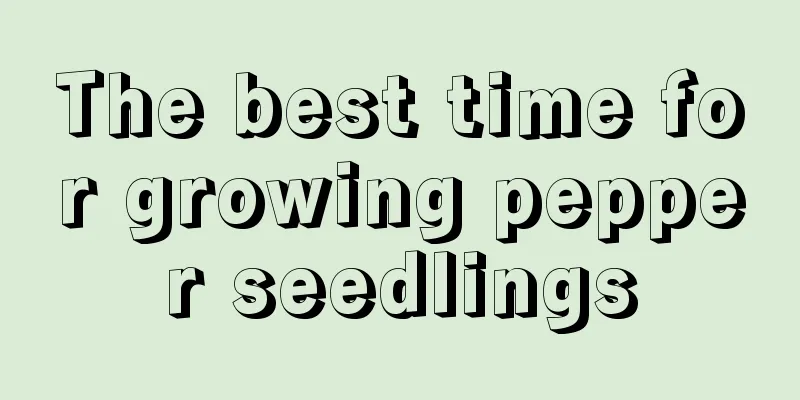The best time for growing pepper seedlings

|
Chili pepper is a vegetable with great market demand. There are many varieties, some of which are more fragrant and some are more spicy. The best time to grow pepper seedlings is usually between March and April in spring. During this period, the climate is pleasant, the sunshine is abundant, and there is a large temperature difference between day and night. These conditions are conducive to the germination and growth of pepper seeds . In addition, the rainfall during this period is relatively appropriate and the soil moisture is just right, providing an ideal environment for the healthy growth of peppers. Let’s take a look at the best timetable for growing pepper seedlings. 1. The best timetable for raising pepper seedlings The best time to plant pepper seedlings varies by region, here are some specific schedules: In the middle and lower reaches of the Yangtze River: sowing and seedling raising are generally carried out from October to November. North China and Northeast China: Sowing time is usually from February to April. South China: Seedling raising time is relatively early, usually from December to January of the following year. In the southern region, the age of pepper seedlings is about 90 to 100 days, while in the northern region, the age is about 60 days. In addition, the seedling raising time for spring pepper cultivation is generally from January to February, and the seedling age is about 90 to 110 days. Sowing at the right time according to the transplanting period and the seedling stage has a great impact on the later yield and quality. The sowing time for spring planting in the north is late January, and the autumn planting time is mid-to-late July. 2. Seedbed Construction Site selection requirements: A location that is sheltered from the wind, facing the sun, with high terrain and good drainage should be selected to facilitate management and transportation, and easy to maintain. Priority will be given to land that has not been used to grow Solanaceae (such as eggplant, tomato, potato) and melon (such as winter squash, pumpkin) vegetables in the past 1-2 years, as well as land that has not been used to grow tobacco. Land where the previous crop was beans, onions, garlic, celery or ginger is more suitable. The ideal site should have buildings or trees on the north side to block the cold wind, no obstructions on the east and west sides to ensure sufficient sunlight, and no obstructions on the south side. Seedbed orientation: It is recommended that the seedbed be set up in an east-west orientation, with the eastern end slightly to the south to obtain the best light conditions. Seedbed construction: Build a ridge about 15 cm high. Apply 3-5 kg of 15-15-15 potassium sulfate compound fertilizer , use a micro-tillage machine to deep plow the soil at least 15 cm, remove stones and other debris, and level the ground. Water thoroughly to ensure the soil is moist to a depth of at least 10 cm, and add 30 ml of highly effective chlorpyrifos or insecticides such as trichlorfon, chlorpyrifos or thiophanate-methyl (2-3 taels) to the water to prevent underground pests and earthworms. At the same time, 200 microbendazim or carbendazim can be added to prevent fungal diseases. Sprinkle the sifted fine soil as seed bedding soil, then evenly sprinkle the pepper seeds (mixed with the fine soil), and then sprinkle three more times to ensure even distribution, and then cover with 1-1.5 cm thick sifted fine soil (it is recommended to add 2 taels of mycobacterium or carbendazim to prevent fungal diseases. If it has been used in the early stage, there is no need to re-apply). Spray herbicide (2 tubes of seedbed cleaner plus 4 pounds of water). Finally, cover the ground film, fix one end with a rope, pull the other end of the rope over the ground film, cover the shed form, and ensure that both sides and ends are sealed. In short, when determining the time for pepper seedling cultivation, local climatic conditions and cultivation methods, as well as temperature management during seedling cultivation, must also be considered to ensure the healthy growth of pepper seedlings.
|
>>: Cucumber seedling raising time and method
Recommend
Which month is best for sowing lentils?
Hyacinthus lentil , also known as black-eyed pea ...
Summer and winter of gerbera
How gerbera survives the summer It is relatively ...
Corn planting methods and management techniques
Corn, as an extremely common food crop, plays an ...
How often should I water the Jade Dew? When is the best time to water it?
How often should I water the Jade Dew? When growi...
How to grow flying saucer melon
1. Maintenance methods 1. Temperature: It likes a...
How to grow red camellia at home
Red Camellia Growing Conditions The suitable grow...
How to use benzylpyraclostrobin
Benpyraclostrobin is a common closed herbicide , ...
What to do if hydroponic bamboo turns yellow
1. Change water in time Cause: If the water is no...
Cowpea planting technology and management methods
Cowpea, also known as green bean, string bean , e...
How to repot the ash tree
1. Remove the plant The ash wood needs to be repo...
When is the best season to plant lilies?
Lily planting season and time The planting of lil...
How to grow potted calamus
1. Lighting environment It likes sunlight and can...
Can Desert Rose be planted in the ground?
Can Desert Rose be planted in the ground? Desert ...
How to propagate yellow hair palm
sowing If you want to propagate by sowing, you mu...
The efficacy and function of Liu Jinu
1. Malaria It actually has a relatively large eff...









